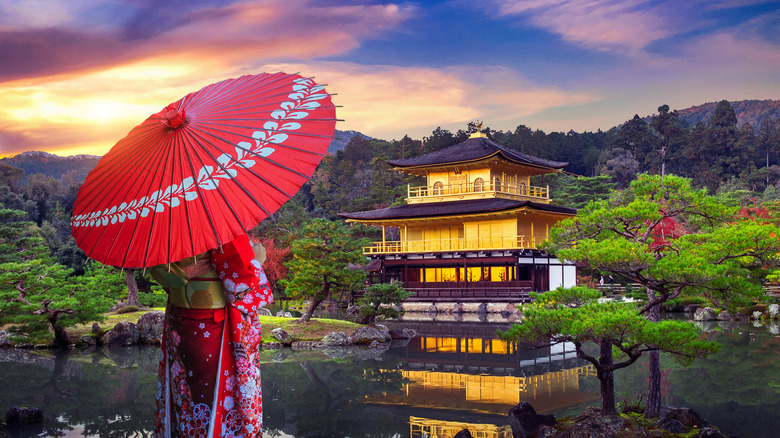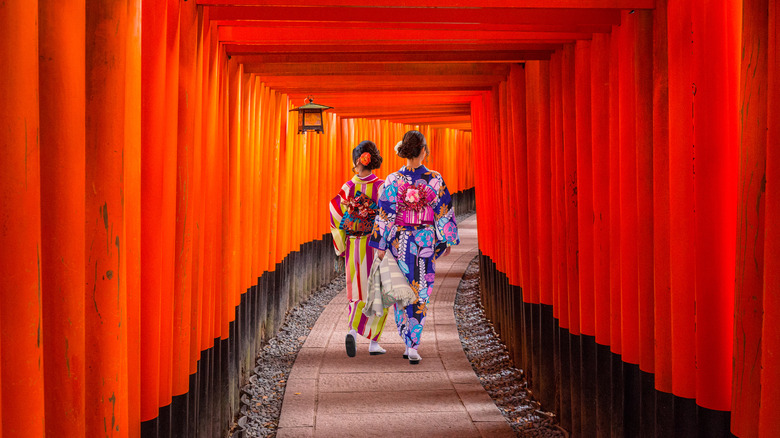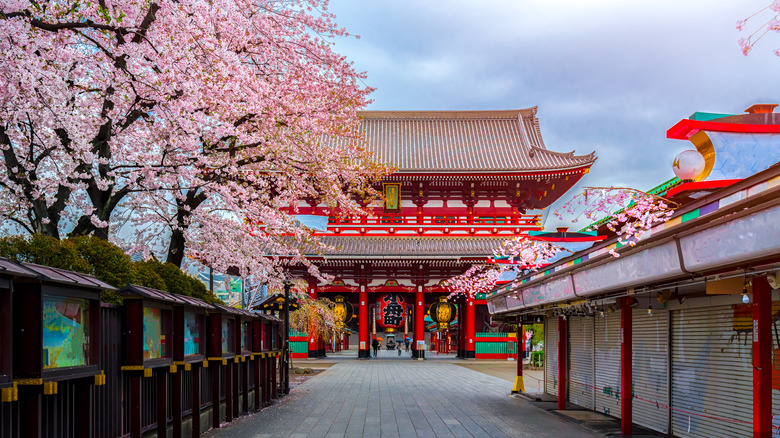What's The Difference Between Japanese Temples And Shrines?
On the surface, modern-day Japan can look like a country of extreme contradictions. Patient and ritualistic traditions like tea ceremony abut the gonzo, glitz-and-glamour nightlife of downtown Tokyo. A minimalist, even austere, design tradition meets the poppingly bright color palettes of Harajuku's "kawaii" cosplay culture. A history of sword-wielding, savage samurai squares off against business card-wielding legions of bedraggled, train-bound commuters decked in identical suits. And amongst it all, between the ultra-ancient and ultra-modern, sit shrine after temple in city after village.
Even if people don't realize it during their busy travels, it's the cultural bindings of Shinto and Buddhist ideology that fuse Japan's disparate faces into one whole. Of course, it helps that Japan is a largely homogenous, island-bound population living relatively isolated for centuries. People know how to behave and what to expect from each other. Even nowadays, when the amount of non-Japanese people in the country is at its highest in history, foreigners still amount to a mere 3% of the population (per Statista).
Sometimes, while going to and fro, Japanese people will pause to stop by one of Japan's 160,000 combined shrines (Shinto) or temples (Buddhist) (figure per Japanistry). Stone shrines, like little houses for spirits, are tucked behind skyscrapers and alcoves in home gardens. They're situated by the most far-flung mountain hiking trail, waiting for prayers. Temples, on the other hand, stand tall. They beckon visitors to pause and peer inside first the temple, then themselves. Both come from different traditions, but live side by side.
Shrines to the spirits of Shinto
The spirits are everywhere, ancient Japanese people felt. Trees, streams, the smallest crumble of soil, the highest snow-capped heights of Mt. Fuji: Everything is alive and must be thanked. This belief, often called "animism," is present among countless indigenous peoples, such as those of North America (per the Dialogue Institute). In Japan, this type of reverence for the natural world is called "Shinto." Shinto shrines ("jinja") are places where specific spirits have been enshrined and given a bit of respectful space, so to speak.
Izumo Taisha, for instance, considered Japan's oldest shrine built in the early 700s, has a large main hall with a typical wave-shaped roof, as Japan Guide shows. It was built in honor of one of Japan's central creation deities, Okuninushi no Okami. There are gates ("tori") leading to the shrine which symbolize the passage into a holy space, a water purification basin, wooden plates written with visitor's wishes, guardian fox statues (at some shrines these are dogs or lions), and more. Shrines can be this complex, as Japan Guide also outlines, or just be a little, wooden, box-looking thing. Visitors are supposed to approach, clap twice, then bow twice, say a prayer, and be on their way.
Despite such ritualism, it's incorrect to described Shinto as a "religion" in a Western, doctrinal, dogmatic kind of way. It's become more procedural over time, but at its core, Shinto is a thing of sense and sentiment.
Temples for respect to the Buddha
In contrast to native Shinto shrines, Japanese temples come from Japan's imported belief system, Buddhism. As the BBC explains, Buddhism made its way to Japan through Korea in the 12th century. Before that, it had passed from India to China in the sixth century, then China to Korea about 100 years later in the seventh century. Along the way, Buddhism accumulated various cultural elements, specifically Taoist and Confucianist precepts from China. These all landed in Japan, got integrated into Japanese culture, and resulted in Japan's own fusion version of Buddhism, "Zen."
Temples can be distinguished from shrines by their typically ornate architecture and distinctive, wide-set roofs, and ancillary buildings for monks' living quarters. Like shrines, visitors pass through a gate to enter, in this case called a "sanmon," which often contains ferocious-looking, humanoid guardian statues (Japanistry has a brief overview). They wash their hands to purify themselves, and sometimes stop by a large, metal incense burner for another smoke-based purification. Instead of clapping and bowing, visitors ring a bell to notify the gods that they've arrived. The interiors of temples — which you can see from the bell but not enter — are often full of gold-plated regalia, decorations, and statues of the Buddha.
Senso-ji (the "ji" means temple) in Asakusa, Tokyo, is one of the most well-known temples in Japan, as Tokyo Cheapo outlines. Folks visit it throughout the year, but especially on New Year's Day to start things off on the right foot.


